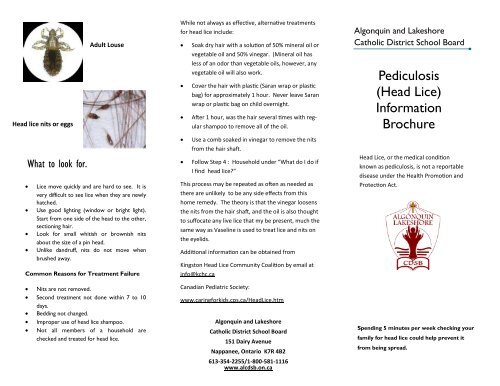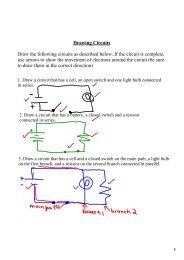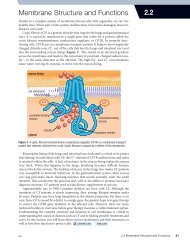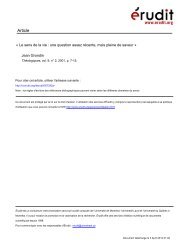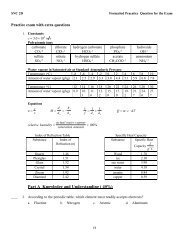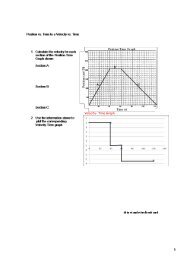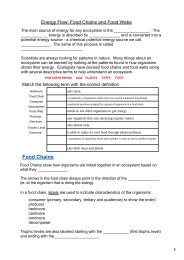Pediculosis (Head Lice) Information Brochure - Algonquin and ...
Pediculosis (Head Lice) Information Brochure - Algonquin and ...
Pediculosis (Head Lice) Information Brochure - Algonquin and ...
- TAGS
- pediculosis
- brochure
- algonquin
Create successful ePaper yourself
Turn your PDF publications into a flip-book with our unique Google optimized e-Paper software.
What are <strong>Head</strong> <strong>Lice</strong>?<strong>Head</strong> lice are tiny little insects that live onthe hair <strong>and</strong> scalp of human heads. They layeggs called nits.They require a human host in order tosurvive.<strong>Lice</strong> do not care if you are female ormale, young or old, clean or dirty orwhat season it is. If they have a humanhead to live on, they will survive.<strong>Lice</strong> do not cause or transmit disease.Itching <strong>and</strong> scratching of the scalp is themost common symptoms <strong>and</strong> oftenthere are no symptoms at all.How do people get head lice?Sharing combs or brushes with a personwho has had lice.Sharing bedding, clothes, towels, hats,helmets, stuffed toys <strong>and</strong> pillows with aperson who has head lice.Making head to head contact with aperson who has head lice.People cannot get head lice from family pets,dogs, cats, trees, grass or toilet seats.What do I do if I find head lice?DON’T PANICStep 1.Check all family members in the household.Begin by checking around the ears, at thenape of the neck <strong>and</strong> at the crown of thehead. Then continue to check the rest ofthe head.STEP 2.Treat all family members who have lice or nits with asafe <strong>and</strong> appropriate head lice product available at anypharmacy or drug store.See a doctor or nurse practitioner about the choices fortreatment if the person who has lice is/has:Pregnant or breast feeding.Less than 2 years old.Skin of the scalp is broken or infected.Skin allergies or other skin conditions.Allergic to ragweed, chrysanthemum.Allergic to products used to treat head lice.<strong>Lice</strong> may be found on eyebrows, eyelashes or beard.ImportantNo product on the market today kills all nits .A second treatment within 7 to 10 days isneeded to kill lice that have hatched after thefirst treatment.Treat all members of the household who have lice <strong>and</strong>/ornits:Step 3: Nit RemovalComb hair with a regular comb to remove snarls inthe hair.Work from one side of the head to the other, separatinghair into small sections.Use a nit comb or fingernails to strip all nits fromthe hair.Using a toothbrush, clean the nit comb of nits <strong>and</strong>lice.5. Dispose of all nits after treatment <strong>and</strong> continueto check for nits until the second treatmentis applied.Step 4. Household Treatment<strong>Lice</strong> <strong>and</strong> nits can survive for a short period of timeaway from the scalp (48 hours)To prevent lice from coming back, washclothes, hats, scarves, coats, towels, sheets,pillows, pillowcases, blankets, stuffed animalsetc., in hot water or dry on hot cycle for 20minutes.Items that cannot be washed can be sealed ina plastic bag for 2 weeks or dry cleaned.Soak combs <strong>and</strong> brushed in hot, soapy waterfor at least 10 minutes.Vacuum furniture, rugs <strong>and</strong> vehicle seats, includingthe head rests.It is not necessary or recommended to spraythe household with insecticides or commerciallice sprays.DO NOT USE gasoline, varsol, kerosene,lamp oil, motor oil, or any flammable solventsas a treatment for head lice.DO NOT USE any products that are intendedfor use on animals such as flea or ticktreatments.If head lice persists, talk to your doctor, pharmacistor nurse practitioner for other treatments.


